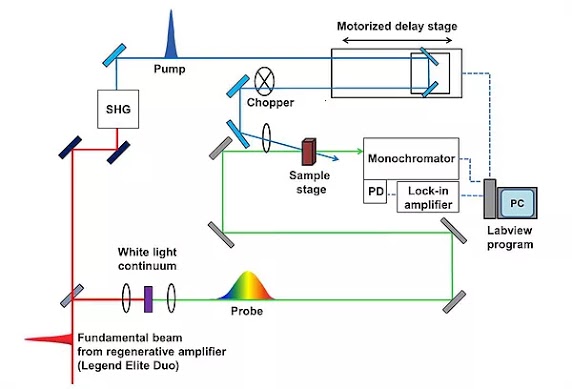나노, 바이오, 에너지 관련 재료 및 소자의 개발에 있어서 그것들이 가지고 있는 근원적인 특성을 탐구하기 위해서는 기존의 전자적인 방법의 측정뿐만 아니라 극한의 시공간 현상을 연구하는 원천기술을 필요로 한다. 펨토초 (1000조 분의 1초) 대의 짧은 펄스폭을 가지는 극초단 광원을 이용한 분광학적 접근은 기존의 측정법이 가지는 한계를 뛰어넘을 수 있게 활용될 수 있다. 이러한 광학 측정방법을 이용하면 양자점 (quantum dots), 유기 폴리머 (organic polymers), 무기 반도체 (inorganic semiconductor) 등과 같은 소재에서 일어나는 초고속 현상을 규명할 수 있으며, 이를 토대로 효율이 극대화된 소자를 개발을 위한 정보를 제공할 수있다. 본 연구에서는 펨토초 레이저를 이용한 pump-probe (=transient absorption spectroscopy) 분광 장치를 이용하여, 여러 기능성 (functional) 소재의 들뜬상태 (excited state)에서의 광에너지 운반자 (carriers) 동역학을 규명하고자 한다.
Nano material science, quantum dot, organic solar cell, high power femtosecond laser, femtosecond spectroscopy, wavelength conversion
Femtosecond pump-probe experiment is typically achieved by splitting the femtosecond pulse into two identical pulses. Optical path of each pulse is precisely controlled by a motorized translation stage. Finally, the relatively delay-varied two beams are combined at the xss-object material. A time window totally depends on the scan range of the translation stage. A pump, which is one of replica, has relatively large intensity, and is tuned to a specific wavelength within the absorption region of the material. Typically, a probe, which is another replica, covers broad spectral range from 350-1100 nm using white light continuum generation. Spectral and kinetic data from the femtosecond pump-probe experiment is used for investigating photo-excitation events with ultrafast time resolution i.e. photo excited carrier dynamics. Lock-in detection, which involves chopping the pump pulse, is used for increasing signal-to-noise ratio (SNR) because of intrinsic low SNR of the photo-excitation events. Sometimes, especially with the low repetitive laser, the probe beam is split into two to generate reference beam, which propagate sample without overlapping with the pump beam. And the probe and its replica are detected respective photo detector.
 Figure 1. Transient absorption spectrometer setup
Figure 1. Transient absorption spectrometer setupAs mentioned above, the lock-in detection is applied to our ultrafast pump-probe measurement. The lock-in detection involves chopping the excite pulse at a given frequency and detecting at that frequency with a lock-in detector. The excite pulse periodically changes the sample transmission (or absorption) seen by the probe pulse. Thus, ultimately, the lock-in detection automatically subtracts off the transmitted power in the absence of the excited pulse (e.g ΔT/T={T(with pump)-T(without pump)}/T(without pump).
The lock-in amplified signal was collected in time domain by controlling motorized delay stage and in spectral domain by scanning wavelength using the monochromator. Consequently, ultrafast kinetics and spectra of the target sample could be measured. And such procedures were managed by a Labview (National Instruments) program.
Differential transmission (ΔT/T) can be both positive and negative values depends on which dynamics are involved. Positive DT represents increase in the transmission of probe while the pump is active, which means photo bleaching (PB) or stimulated emission (SE) occurs. While, photo-induced absorption (PIA) yields negative DT signals.

[1] Terry Park, Ingu Lee, Seong-Jin Son, Youngbin Na, and Do-Kyeong Ko "Transient Absorption Spectroscopy of a Twisted Charge Transfer (TICT) State in a DCM Molecule Analyzed by Isosbestic Points" Journal of the Korean Physical Society, March (2022).
[2] Terry Park, Ingu Lee, Seong-Jin Son, Youngbin Na, and Do-Kyeong Ko "Photochemical Pathways of 8-Oxo-2'-deoxyguanosine under Photodegradation" AIP Advances, 12, 025109 February (2022).
[3] Cheol Jo, Nam Joong Jeon, Seung Joo Lee, Chan Su Moon, and Do-Kyeong Ko "Ultrafast Photo-induced Carrier Dynamics of FAPbl3-MAPbBr3 Perovskite Films Fabricated with Additives and a Hole Transport Material" Chem. Phys. Lett., 784, 139100 December (2021).
[4] In-Sik Kim, Cheol Jo, Rira Kang, Dong-Yu Kim, Seong-Jin Son, In-Wook Hwang, and Do-Kyeong Ko "Fabrication-Method-Dependent Excited State Dynamics in CH3NH3PBi3" Sci. Rep., 7, 16516 November (2017).
[5] In-Sik Kim, In-Bok Kim, Dong-Yu Kim, Seong-Hoon Kwon, and Do-Kyeong Ko "Effect of Fluorine Substitution on the Charge Carrier Dynamics of Benzothiadiazole-Based Solar Cell Materials" Macromol. Rapid Commun., 37, 1242-1248 May (2016).
[6] In-Sik Kim, Seong-Hoon Kwon, Juhwan Kim, Dong-Yu Kim, Do-Kyeong Ko "Excitation-intensity-dependent charge carrier dynamics in thienylenevinylene-phthalimide copolymer based thin polymer films" Polymer, 63, 208-213 April (2015).
[7] In-Sik Kim, Soo-Young Jang, Terry Park, Cheol Jo, Dong-Yu Kim, and Do-Kyeong Ko "Femtosecond transient absorption dynamics in low bandgap polymer solar cell materials including poly(thienylenevinylene) derivative and benzothiadiazole moiety" Chem. Phys., 461, 29-33 September (2015).
[8] In-Sik Kim, Byoung-uk Sohn, Sung In Hwang, Chang-Lyoul Lee, and Do-Kyeong Ko, “Chirp Independent Time-Resolved Spectroscopy by Self-Reference Method,” Laser Phys. 24, 0457701 March (2014).